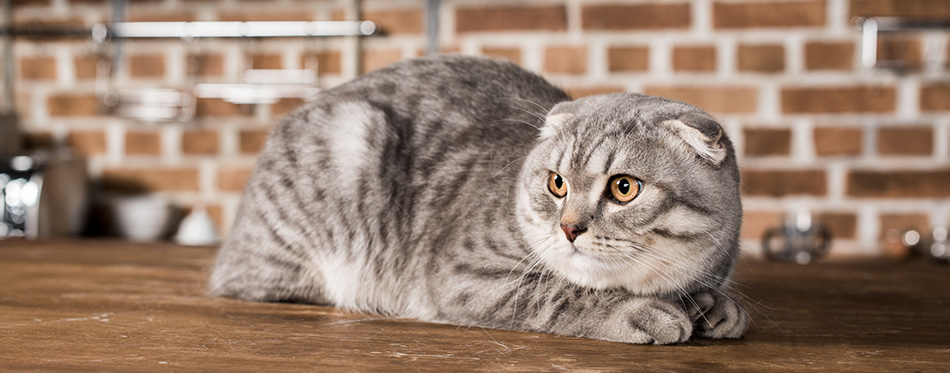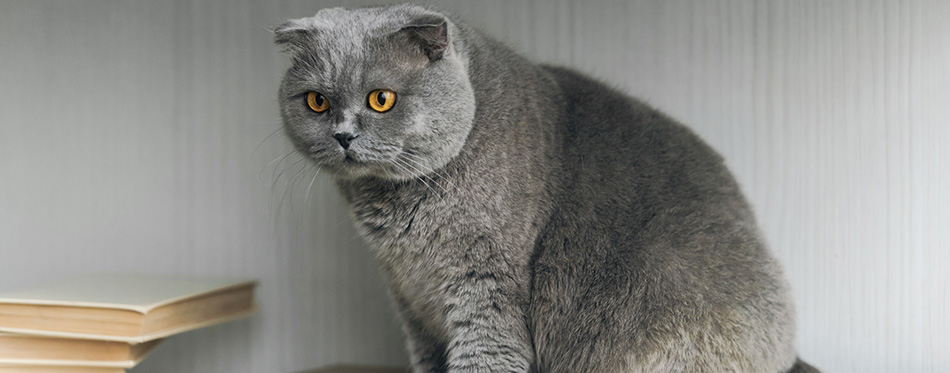This cuddly four-legged ‘owl-face’ cat is truly a very intriguing breed. Stay with us as we examine the history, personality and vital facts of the Scottish Fold cat. Who knows, it may well be the next pet addition to your home.
The attractive ‘cuteness’ of a Scottish fold cat is mainly attributed to its small bent ears which fit like a cap around its round head. This owl-like appearance coupled with round shoe-button eyes, a fluffy solid medium-sized round body would make your heart melt at first glance.
Due to their uniqueness, Scottish fold cats are very popular with celebrities in particular. They also come in a variety of coat colors including blue, black, red, and sometimes lavender, although most breeders prefer an all-white shiny coat. They also have copper-colored eyes – but their eyes are not always copper-colored so don’t be discouraged if you are paired with a green-eyed fluffy barn owl lookalike. Their medium-sized bodies are made up of compact muscle weighing between 6 to 13 pounds and 10 to 12 inches in height. A healthy Scottish Fold can live up to 14 years.
The Scottish Fold is an unassuming little pet who adapts very well to any home situation including noisy children and other house pets. This very special cat breed is generally sweet, easy-going and quiet which makes them good ‘peoples’ cat.
Some Scottish Folds have their ears in a single fold which is loose at the back and tight in front – but most pet owners find the double or triple fold (tight creases that fits like a cap on the head) more attractive. Because of the rarity of the folded ears and the fact that not all the kittens in the litter will have folded ear, demand outweighs the supply. This fact makes them quite expensive on the market.

History of the Scottish Fold Cat
Once upon a time in Scotland, there was a lovely little cat called Susie. Susie was a mouser in a barn in the Tayside region of Scotland. She was white and flurry and had unusual folded ears. It’s a wonder no one took notice of her until 1961 when a local shepherd and cat fancier took interest in her.
William Ross was so smitten with Susie that he bought one of her kittens (Snook) which also had folded ears. With the help of a friend – who happened to be a geneticist – they began to breed this special variety. Soon other breeders became attracted to this unusual looking cat. Soon after, the pair discovered that the mutated gene responsible for the bent ears was a dominant gene. And so you only need one parent with folded ears to have kittens with the abnormality.
In 1971, Scottish Folds were officially introduced to Americans and in the middle of that year, most cat associations in North America had them listed. The Cat Fanciers Association granted them recognition in 1973 and gave the championship status in 1978. Later in 1980, the long-haired version of the cat became somewhat popular and recognized by international breeders.
In 1979, a certain Dr. Neil requested for three of Snook’s kittens to be brought to his research facility in Massachusetts. He was conducting research on spontaneous genetic mutation and thought the kittens could help him uncover some mysteries. And even though, they weren’t able to help him with his work he still found good homes for them. Hester, one of the female cats, was given to Salle Wolf Peters a renowned breeder in Pennsylvania.
The long-haired Scottish Fold is known as the Highland Fold by the American Association of Cat Enthusiasts, United Feline Organization and the American Cat Fanciers Association.
Today, Scottish Fold breeders are only allowed to use an American or British Shorthair in their breeding program. This is to prevent further health problems and to keep the breed as healthy as possible.
Quick Facts about the Scottish Fold Cat
It is quite difficult to establish the exact mix breed of today’s Scottish Fold although all Scottish Folds can trace their ancestry back to Susie, the barn cat. Modern Scottish Fold cats were bred with a variety of other breeds to achieve its present look.
- All Scottish folds are born with straight ears
Yep, don’t go looking for new-born kittens with folded ears. Their ears start to fold after 3 – 4 weeks. And sometimes the ears would never fold and these ones are known as the Straights.
- Their folded ears are a by-product of a genetic mutation
The most distinguishing feature of the Scottish fold is its ears. Their ears appear folded, bent forward and lying close to their heads. Hence the name Scottish Fold. This apparent abnormality is caused by a dominant gene which mutated spontaneously. This trait affects the cartilage formation in its body. Fortunately, or unfortunately, only its ears carry the visible signs of this defect. The rest of its body continues to be in a round, cuddly state.
- They were once not called the Scottish fold
Formerly, before breeders and cat fanciers decided that they preferred tightly looped ears to floppy one, they were called Lops or Lop-eared. This name was cultivated for their resemblance lop-eared rabbits when their bent ears were quite loose. But most people preferred them with tight-fitting ears which resulted in selective breeding. And now most Scottish folds have cap fitting folded ears.
- The Scottish Fold isn’t famous in Europe
After its participation in a show in 1966, the largest cat organization body in the UK decided to ban the Scottish Fold from shows. By 1967, cat owners were prevented from registering the pussycat in shows because its deformity was quite worrying.
The Governing Council of Cat Fanciers worried that their bent ears would cause other health implications such as ear infections, mites or even deafness. And so making it popular would only encourage breeders to produce more of the ‘deformed’ kitty. If you are looking for more options, check out our guide on cat ear cleaners.
- Scottish Folds are social media stars
Maru is a famous internet cat. Her long list of social media followers should be enough to tell you that the Scottish fold is a pop culture fixture. Also, the buzz surrounding Taylor Swift’s two adorable Scottish Folds, Meredith Gray, and Olivia Benson is enough to portray their novelty. Ed Sheeran also owns a delightful Scottish Fold.
- Masters of odd non-cat like poses
The Scottish fold would charm the socks off your feet in its delightful ‘Buddha sit’ pose. Sometimes the Scottish fold prefers to sit like a human (on its hunches with its forelegs crossed calmly on its upper body). Other weird poses include the frog stance which consists of it lying flat face down on it belly like a frog. There is also the ‘dead beetle’ pose which has it lying on its back with legs raised straight into the air.
- Why do they eat with their paws?
Scottish Folds are fond of eating with their paws and this human-like trait has been traced back to their ancestry. Though now domesticated, the Scottish folds lineage is deeply rotted in the wild where food for hunted and protected from others. This innate trait of catching and holding on to prey whilst eating could be the reason your cat grabs its food away from the bowl.

Things You Should Know
There are a few important points to note if you are thinking of owning a cat from this attractive breed.
Health
Its health is a mixture of dread and quiet appeal because it is the genesis of those cute looped floppy ears. Although their folded ears look cute, this is caused by a genetic abnormality which may cause them to have short painful lives riddled with health complications.
Your cat may suffer from incurable arthritis (degenerative joint disease) in its knee joints and ankles which makes movement painful and difficult. Sometimes the tail is also affected and can develop a rigid stiffness that needs to be handled with care.
You should also be on the lookout for Polycystic kidney disease (PKD) and report to the vet immediately you notice weight loss, reduced appetite, or vomiting. Your feline may also have heart complications but this hasn’t been proven to be hereditary yet. Hypertrophic cardiomyopathy symptoms include short raspy breathing, weak pulse, bluish discoloration of footpads and sudden paralysis in the hind limbs.
Thankfully, modern Scottish folds are bred by experienced breeders who go carefully go through the right procedures to guarantee healthy kittens for your enjoyment.
Related Post: Cat Food for Kidney Disease
Feeding
Scottish folds tend to be foodies and may become overweight if not monitored. Their diet should basically consist of lots of proteins and fewer carbohydrates. They have sensitive stomachs which make them react terribly to carbs. Another side effect of a carb-rich diet for a Scottish Fold is the risk of obesity. Which can be difficult to detect because they are natural round with soft-edges. Control food portions to keep your Scottish folds weight in check.
A mixed diet of dry and wet foods is good for your cat. Wet foods are essential for cats since most don’t like drinking water, it provides the needed moisture to stay hydrated. Matured cats (8 months upwards) can consume dairy products, cooked or roasted proteins (beef, chicken, fish, and shrimps) soups and vegetables. Do not feed your cat raw meat as this could lead to a Toxoplasma infection. Also, one egg yolk (raw or boiled) a week is recommended.
Sometimes your Scottish Fold may prefer eating with its paws and this could be because of several reasons. One, a deep bowl will have its sensitive whiskers being pushed back which is very discomforting and sometimes painful. Secondly, most cats dislike having their food bowl close to their drinking water and so they would rather eat with their paws at a comfortable distance. Or they would eat with their paws because that is what they want to do!
Fresh clean water should always be provided. Leaving their water bowl unchanged for days on end could turn the water cold which can cause dangerous conditions like pharyngitis and later pneumonia. So pleases remember to change the water at least once a day.
For more guides on choosing the right cat food, you may wish to check out our reviews of the best wet cat food, senior cat food, cat treats, high fiber cat food and cat food for bengals.
Care
Always make sure the litter box is clean and filled with fresh dry sand. A clean litter box will cut off some grooming time and make happy lively cats too. And since they tend to shed a lot, you should get yourself a pet vacuum cleaner. Find out more about self-cleaning litter boxes here.
The Scottish fold loves attention and would become depressed when ignored or left alone for a long time. It’s best to engage them in physical and mental stimulation activities. The Scottish Fold is a moderately active cat which means you won’t see it doing too much chasing, running around and tree climbing. Keep a bunch of puzzles and teaser toys on hand but their much-loved part is anything that includes their human caregivers too. For more options head over to our guides on cat toys and laser pointers for cats.
Caring for a Scottish Fold would not break your back or bank account. All they need is a clean home, good food and to be lavished with love.
Grooming
Grooming is very important because it reduces the occurrence of hairballs inside your cat. Hairballs are hairs cat consumes when grooming itself. Additionally, grooming eases clean up time in your home since they tend to shed a lot. A good brushing once a week should do but if your Scottish Fold is long-haired, then it needs more frequent brushing (3 to 4 times a week). You may also need to trim and look out for things which may be tangled in its coat.
The feet and claws also need to be cleaned daily because of their habit of scratching the litter box. If you don’t clean its feet, your cat is bound to do that by licking them and getting itself sick. Claws should also be trimmed as long claws have been ripped out unknowingly after getting caught on things.
Bathing is somewhat a no-go area for most cats so once a month should be ok for your Scottish Fold. Remember to use only shampoos specifically formulated for cats and dry thoroughly with a towel. Do not brush whist the fur is still wet.
Use medicated toothpaste and a soft brush made for cats to brush their teeth at least once a week. This exercise would prevent periodontal diseases and should last for about 5 minutes per session.
Special attention must be paid to the folds in the ears. These should be cleaned daily with clean wet wipes (50/50 mixture of warm water and apple cider vinegar) and thoroughly dried. You should also inspect for ear mites, fleas, sores (from scratching itself) or wax build-up. Take your pet to the vet as soon as you detect a foul smell coming from its ears.
Also, clean the corners of its eyes but be careful not to use the same ends of the cloth. You wouldn’t want to spread ay infection from one eye to the other.
For more help on cat grooming, you may wish to read our guides on the best cat nail clippers, brushes for cats, cat grooming gloves and cat shampoos.
Temperament
The Scottish fold is the sweetest calmest cat you could ever own. It loves to be around its human caregivers and is likely to have a favorite amongst the lot. They are inquisitive and highly intelligent so don’t be surprised if your drawers are ‘miraculously’ opened and a few things displaced.
Although Scottish Folds are not talkative, they won’t hesitate to vocalize their wish or displeasure. They rarely speak for the sake of small talk, they usually have a specific reason for using their voice.
They like to be smart pants showing off their flexibility in amusing odd ways like lying flat on their bellies with all four legs outstretched. Or flat on their bellies with the legs straight up in the air. It can be rather interesting to watch them eat too. They usually eat with the paws sitting on their hind legs in a comical human pose. Also, they prefer to drink from running water than their water bowl. There is never a dull moment with a Scottish Fold at home.

Summary
Introduce your newly acquire Scottish Fold carefully and gently to its new home. You may also arrange for a vets visit to for a thorough check-up and some recommendations.
Do not buy from a backyard breeder. It important to purchase your cat from a certified breeder and this would ensure you have a healthy cat for your pleasure. You may also run a test to ensure that you are not purchasing a sick pet b checking for any stiffness in its tail.
Scottish Folds may need more attention than other cats and I would advise against leaving them alone at home for long hours. It’s best to keep your cat indoors for safety against attacks from neighborhood dogs or the occasional coyote. An indoor Scottish Fold is unlikely to catch some feline disease from a foreign cat. Or risk being taken by someone who would like to own such a fine-looking cat without paying for it.
The Scottish Fold is definitely going to be your new best fur-end!
Source:
- About the Scottish Fold – The Cat Fanciers’ Association

